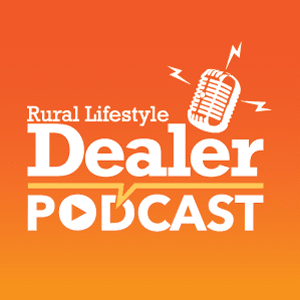Pictured Above: Alex Chausovsky is Director of Speaking Services.
Rural Lifestyle Dealer kicks off the year talking with Alex Chausovsky of ITR Economics to help dealers prepare for the economy in 2020 and beyond. He says dealers should be ready for a slight economic downturn in the industrial economy expected in the first half of 2020, followed by a rising trend later in the year.
Learn more about what’s ahead in this Q&A.
Rural Lifestyle Dealer: What economic trends are you forecasting for 2020 and 2021?
Alex Chausovsky: The economy over the course of 2019 has been slowing, meaning the volume of economic activity has been expanding, but at a decelerating pace. The industrial production index growth peaked in October 2018 and has been declining in 2019. We expect the pattern to continue in the first half of 2020.
We are actually expecting a mild and brief recession in the industrial sector, culminating in a cyclical low occurring in the mid-2020 timeframe. The good news is that it will be brief and mild. By the second half of 2020, we're expecting the emergence of the next rising trend in the economy.
We pay attention to a lot of different leading indicators and some of them are already starting to confirm that expectation of a rise. For instance, the housing market is known to be the canary in the coal mine and single-family housing starts typically lead industrial production by about 8 months. Housing right now is still down, year over year, but when you look at the short-term, the previous 3 months shot up into positive territory compared with the same time last year.
“By the second half of 2020, we're expecting the emergence of the next rising trend in the economy.”
The housing market should flourish over the next 3-6 months and that is a good sign for an upside momentum to develop in the industrial economy during the second half of next year. We believe that 2021 will be the next growth year.
RLD: What should dealers do now in advance of the expected mild recession and then the upturn?
Chausovsky: Our main advice to businesses is to reflect and proactively change your behavior to accommodate this slowdown, but don’t lose track of forward-thinking momentum. You have to think half a business cycle ahead and put together a plan now that you can act on in the mid-2020 timeframe. This will ensure your company can take full advantage of that next rising trend.
What I mean by that is that you need to ask yourself questions like, “Do I have the right people? Do I have the right capacity? What kind of equipment do I need? Do we have a CRM system as well as marketing plans in place?” Addressing these questions will help you gain a competitive advantage during the next rising trend, outperform competitors and gain market share.
RLD: Can you explain more about a business cycle? What kind of timeframe are you talking about?
Chausovsky: There's not a specific period of time that we look at because some cycles are longer than others. However, a business cycle, from peak to trough, is generally about 12-18 months.
For instance, the last peak in the industrial production index happened in October of 2018, and we expect a mid-2020 cyclical low in the next business cycle transition. We've gone from peak to low over the course of 20 -22 months, but this cycle has been longer than normal due to the positive impact of the tax reform package implemented in 2018.
RLD: We’re familiar with the idea of 5-year plans and long-term strategic plans, but dealers should also be developing plans to address the idea of a business cycle, is that right?
Chausovsky: Absolutely. Five-year plans are much broader and more strategic in nature. There is generally a different set of initiatives that you enact for a 5-year plan than you would for a business cycle plan.
For the 5-year plan, think about a product roadmap and speculate which markets you want to be in 5 years from now. For shorter term planning, I would look at such things as whether I have the right staffing needs to meet demand over the next year and a half. Do I need to make any investments in my facility or equipment? What do I need to do right now to alleviate any constraints to position myself for that next cyclical rising trend in the second half of 2020 and into 2021.
RLD: What kind of effect will the 2020 election have on the economy?
Chausovsky: There is little correlation between the political process itself and the business cycle. The election will not have a significant impact unless you have a major stimulus of activity in advance of the election. President Trump has talked about enacting another tax cut targeted at the middle-class, or we could see the passage of a bipartisan infrastructure bill that would stimulate economic activity, but the election itself is not going to influence the economy.
From 1976 to the present, the average GDP rate-of-change during Republican administrations was 2.81%; for Democratic administrations the average was 2.85%. All of which leads us to the point we strive to make in our presentations and conversations: it’s policies and what ultimately becomes law or rule or executive order that can (at times) matter, not the party.
RLD: What about the tariffs? How do they factor into the economy and your forecasts?
Chausovsky: There’s been a lot of noise about a Phase One deal with China, but we're not expecting major changes to the trade environment over the course of 2020. As part of the deal, the U.S. will lower one set of tariffs from 15% to 7.5% if China carries through on what they have committed to do. However, that’s a relatively small portion of the overall bucket of products that are currently under tariff.
There's approximately $400 billion worth of Chinese imports into the U.S. that are under tariff right now. Roughly $250 billion is under a 25% tariff. The remainder is at 15%. We see the Phase One deal as largely a symbolic gesture, indicating that the tariffs are not going to be intensified further, but it's not going to be making a huge difference in terms of economic performance.
RLD: Are you still forecasting a major depression close to 2030?
Chausovsky: Yes, that forecast is still very much in play. In fact, the tax reform package only reassured us that we are on the right track with our expectations. We now have a Republican party that is not focused on addressing the debt. Instead, they are focusing on stimulating the economy, so it's important to understand that the tax reforms came at a significant price.
We’re going to incur between $1.5 and $2 trillion in additional federal government debt over the next 5 years or so. We're now over $23 trillion in debt and continuing to add about a trillion dollars every year — and that amount is expected to grow over time. The real question is what is the straw that breaks the camel's back? The government is managing for now by paying just the interest on the debt, but we are currently at historically low interest rates. The amount that we spend on the interest-only portion of our debt is actually going to eclipse the total amount of U.S. defense spending in the near future.
Dealer Takeaways
- Be ready for a slight economic downturn in the industrial economy expected in the first half of 2020, followed by a rising trend later in the year. A more significant downturn is expected by 2022.
- Reflect and proactively change your behavior to accommodate this slowdown, but don’t lose track of forward-thinking momentum.
- A major depression is still forecast for the 2030 timeframe.
- The upcoming election will not have a significant impact on the economy unless there is a major stimulus of activity in advance of the election.
We also have to remember the major demographic changes that are coming. About 40 million baby boomers are going to retire in the next 10 years, which will put a major strain on government spending from the perspective of entitlement programs such as Medicare, Medicaid, Social Security and the like.
Going back to your original question, our expectation for the Great Depression in the 2030s has not only remained, it has gotten stronger.
RLD: We talked about what businesses should be doing to prepare, what should consumers be doing?
Chausovsky: If you look further out beyond the timeframe of 2021, then we're talking about a downturn coming in the economy. In the second half of 2022 and 2023, we’re actually expecting a more substantial downturn. It will likely feel like the most negative economy we have seen since 2009, although it won't be nearly as bad.
My advice to consumers is to make sure you are living below your means, not spending more than you're earning, and saving money. And more importantly, you need to put your money to work. You have about 10 years to develop a nest egg to be able to weather the storm in 2030. Continue to pay down debt, especially debt with variable interest rates like credit cards. Look beyond that as well to student loans, auto payments and mortgages.
There is a bright economic future for the U.S. on the other side, so think of downturns in terms of opportunity. To take real advantage of the economic cycle, you want to do something that is actually counterintuitive for most people. You have to adapt that “buy low, sell high” mentality in everything that you do.

Tune in on Jan. 21 for the full conversation with Alex Chausovsky of ITR Economics about how to prepare your dealership for the economic trends ahead.
When the economy is in a downturn, that's actually a really good time to be investing, especially at the low point in the business cycle, whether that's in your business or in your personal finances.
Looking back at the low point of 2009, there were people who had cash on hand and were being aggressive and buying when everybody else was running for the hills. Those people are all much wealthier today. So, my advice is to be prudent and live below your means; not only to save, but to invest and position yourself to take full advantage of the downturns.
RLD: Is there anything else you’d like to share?
Chausovsky: The one last point I will make is that there's a great deal of noise that exists in the world today, whether that's political noise or the noise from all the various competing media outlets. You have to question where the facts and the data are coming from that are being reported.
More importantly, you need an independent, reliable, and apolitical source of information that will cut through all that noise and help you understand what’s important. So, I hope that your readers know that ITR Economics can be a source like that for them.






